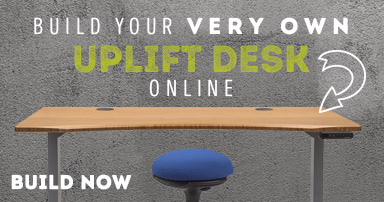How to Select a Monitor Arm
Posted by Human Solution on Apr 22nd 2016
The type of monitor arm you'll need will depend on your workstation’s unique requirements. Addressing these requirements, however, is fairly simple as long as you consider the variables involved.
The first step in choosing a monitor arm is deciding how many monitors you plan to use, as well as the dimensions of each monitor. For many users, a single monitor will often suffice, while others will opt for multi-monitor setups. For single monitor arms, the primary concern will be weight. For heavier monitors such as Apple Cinema Displays, iMacs, and new VESA-compatible all-in-one PCs, we recommend specialized arms such as the HumanscaleM8 and InnovativeiLift. It's also important to determine what size VESA mounting plates your monitor will require. VESA plates are standardized mounting points for PC monitors -- most monitors will use either 75mm or 100mm VESA plates, though some require 200x100mm plates, which must be special ordered. (Please note that Apple products are not VESA compatible and require a special VESA adapter available only from the Apple Store.)
For single monitor arms, the primary concern will be weight. For heavier monitors such as Apple Cinema Displays, iMacs, and new VESA-compatible all-in-one PCs, we recommend specialized arms such as the HumanscaleM8 and InnovativeiLift. It's also important to determine what size VESA mounting plates your monitor will require. VESA plates are standardized mounting points for PC monitors -- most monitors will use either 75mm or 100mm VESA plates, though some require 200x100mm plates, which must be special ordered. (Please note that Apple products are not VESA compatible and require a special VESA adapter available only from the Apple Store.)
For dual or multi-monitor setups, things can be a bit more involved. In addition to checking for weight and VESA compatibility on individual arms, be sure to check the arm specifications to ensure your monitors will be able to fit together while mounted. There's nothing more frustrating than buying a pair of gigantic monitors only to have them unable to fit side-by-side. Determining whether or not you want to use a monitor arm with a crossbar is also important. With a crossbar, you can ensure that your monitors are always at the same height, though you will lose some (if not all) flexibility in rotation range, meaning it may be difficult to "arc" the monitor array to the left or right.
Next, you'll have to determine what adjustment features you want from your arm. Height adjustment is the most complicated type of adjustment, with multiple options that give different methods of operation. The most common types are "fingertip" controlled, bracket mounted, front end adjusted (FEAs), and gas/pneumatic cylinder controlled. Fingertip operated arms are by far the most user-friendly, as you can easily adjust the mount's height with your hands. Bracket mounts are sturdier and clamp directly to a pole, sliding up and down along the pole. This is the ideal "set it and forget it" adjustment system. FEA mounts work in a similar method, though they are pneumatically controlled and mounted directly behind the monitor rather than at the base of the arm, allowing for individual monitor height adjustment. Finally, gas/pneumatic cylinder mounts allow for the entire mount pole to be slid up and down to adjust the monitor height. These mounts are not recommended for multi-monitor use, and both gas/pneumatic and FEA-type mounts must be ordered in accordance with your monitor weights.
Depth adjustment is far simpler. In this case, depth refers to the distance between the monitor pole and the monitor itself -- the longer the depth, the further away from the base you can pull the screen. The depth can be changed by ordering different length arms or arm links, allowing depth adjustment anywhere from 8" to over 24" depending on the lengths used. The arms must fold in to be pushed closer to the base. Keep this in mind when organizing your desktop, and be sure to consider models that allow for arm links to fold in on top of one another to save space, such as the InnovativeEVOII.
Angle adjustment is the third and final type of adjustment, and allows for you to tilt your monitor forwards or backwards to your liking. Almost all monitor arms will allow for the 10-20 degree tilt as recommended by ergonomists, while others allow for far more extreme angles, sometimes even allowing the monitor to be angled toward the ceiling!
Finally, we come to the mount itself. Most arms offer one of four mounting options -- clamp mounts, grommet mounts, bolt-through mounts, and wall mounts. Innovative monitor arms offer a piece of hardware called a “Flexmount” that can be configured into six different mounting options, in case you’re not completely sure what you want. Clamp mounts are the most common mount type, and they work exceptionally well with most desks and monitors. Grommet mounts take advantage of the large wire holes (usually 2-4" across) built into many modern desks and allow for you to solidly secure your monitor with minimal effort. Bolt-through mounts and wall mounts also allow you to anchor your new monitor arm permanently.
Now that you can speak the language of monitor arms, it should be easy to select a great mounting solution like the InnovativeEVOII or HumanscaleM2 that will serve your screens well for years to come. If you're still having trouble or wish to order an arm for a unique monitor configuration, call or chat online with us and our expert staff will gladly help you find a monitor arm system that works for you!




